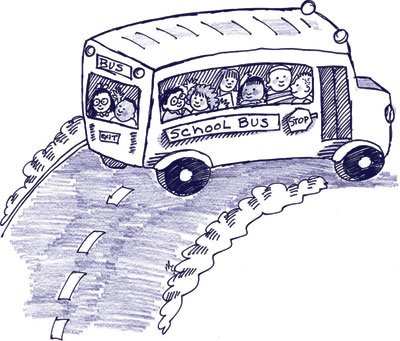Year by year, your children have to master skills to move to the
next grade in school and advance academically.
Year by year, your children have to master skills to move to the next grade in school and advance academically.
In elementary school, students learn the basics and dabble with how to apply those basics to the real world. By middle school, students learn to take those basics through analysis and reasoning. In high school, students move into stages of critical thinking.
And it’s all by design.
Schools determine what children should know and study at various grade levels based on standards set by their state Department of Education and respective school districts. Schools and teachers tailor curriculum guides to meet the needs of their student populations.
Below are nuggets from curriculum guides that pinpoint what children and teen-agers are expected to know as they make their ways through primary and secondary education in public schools. Kindergarten, and first through sixth grades are the crucial learning years listed.
Remember, every child is different and, in many cases, there should be a curriculum to meet his or her needs.
The following guide is what children should be able to do as they enter each grade:
Kindergarten
– Have a simple conversation.
– State name, address, telephone number, basic family information.
– Ask and answer questions.
– Speak in six- to 10-word sentences.
– Relate personal experiences.
– Name colors, body parts, shapes.
– Point to and match colors, body parts, people, animals, food, community workers.
– Decide what’s missing from a story or situation.
– Make up a story about a picture.
– Listen well and follow directions.
– Understand simple opposites (up/down, out/in).
– Act out a familiar story.
– Recognize letter shapes and sounds.
– Experiment with writing.
– Interact with people from different cultures.
– Count to 10.
– Identify numbers from 0 to 10.
– Use the fraction one-half.
– Compare quantities.
– Identify shapes from the real world (box, doughnut, tire).
– Use animal names and characteristics.
– Use some personal hygiene skills.
– Choose clothes according to the weather.
– Recognize seasons.
First grade
– Identify front and back of books.
– Know where to start reading on a page.
– Read and write from left to right.
– Read a variety of words.
– Use singular and plural word forms.
– Complete a sentence with an appropriate word.
– Compare positions (behind, between, etc.)
– Read and write numbers from 0 to 100.
– Tell time to the hour.
– Read a calendar.
– Identify coins and a dollar bill.
– Recognize and create shapes (circle, square, triangle, rectangle).
– Classify many kinds of animals.
– Identify cultural heroes, celebrations and traditions.
Second grade
– Write legibly, with appropriate spacing of letters and words.
– Distinguish between uppercase and lowercase letters.
– Put words in alphabetical order.
– Identify real and make-believe stories.
– Identify the purpose of capital letters, periods, question marks and exclamation points.
– Identify main characters, events and settings.
– Develop and write a story.
– Read three-digit numbers.
– Write numbers to 1,000.
– Add three single-digit numbers.
– Use a ruler to measure inches and centimeters.
– Read time in hour and minutes.
– Use thermometer to read temperature.
– Collect and graph data.
Third grade
– Summarize a story using a main idea, supporting details, cause and effect, time periods, facts, and sequence.
– Demonstrate oral reading skills and make an oral presentation.
– Produce paragraphs, stories, biographies, articles, poems, journals, letters and books.
– Identify and correctly use nouns, verbs, adjectives, adverbs and pronouns.
– Write a friendly letter and address an envelope.
– Identify and use correct capitalization.
– Use a dictionary and glossary of a book.
– Use a computer as a writing tool.
– Mentally add and subtract one, 10 or 100.
– Divide shapes into halves, thirds and fourths.
– Write fractions as decimals.
– Measure weights, dimensions and temperatures of objects and materials.
– Measure to the nearest inch or half-inch; temperature; capacity.
– Define city, state, country and continent.
Fourth grade
– Follow written instructions.
– Use strategies to pronounce new words.
– Use reading strategies to aid comprehension.
– Listen and contribute to small-group discussions; respond specifically to questions.
– Work independently on the computer.
– Multiply one-digit numbers; and two- and three-digit numbers by one-digit numbers.
– Round money to the nearest dollar.
– Add and subtract fractions with common denominators, and decimals.
– Find lines of symmetry in various figures.
– Organize data in a pattern or table.
– Weigh oneself.
– Tell time to the minute and use am and pm
– Describe the properties of air and water.
– Identify stages of a plant’s life cycle.
– Give examples of habitats.
Fifth grade
– Read with expression, clarity and tone.
– Respond to literature through writing.
– Incorporate figurative language into writing.
– Distinguish between run-on sentences, fragments and correct sentences.
– Describe how mountains and volcanoes are formed.
– Read, write and compare numbers more than six digits.
– Compare positive and negative numbers.
– Recall, write and understand addition, subtraction, multiplication and division facts to 12.
– Write equations and identify Roman numerals to 100.
– Locate coordinates on a grid.
– Identify common trees.
– Name bodies of water and determine their importance to U.S. economy.
– Summarize the democratic election process.
– Explain the purpose of the U.S. Constitution and the Declaration of Independence.
– Identify and explain three branches of U.S. government.
Sixth grade
– Use varied sentence structures.
– Summarize and analyze various types of literature.
– Use word-processing programs to publish stories.
– Use computers to improve math and communication skills.
– Solve oral and written problems by listening, taking notes and summarizing.
– Explain the difference between photosynthesis and respiration.
– Identify microscopic organisms.
– Discuss the relationship between force and motion.
– Find the radius, diameter and circumference of a circle.
– Estimate, measure, record and describe temperature change.
– Read, interpret, organize and write conclusions based on data.
– Estimate, compute and convert weight/mass; length; and capacity of objects and containers.
– Identify periods of U.S. history.
Sources: South Carolina Curriculum Standards (Reading/English/Language Arts, Science, Mathematics), S.C. Department of Education; Standards for Quality Education, Richland District 2; Standards for Quality Education – Child Development, Richland 2;
Curriculum guidelines, Keels and Bookman Road elementary schools; Fred Medway, interim dean College of Education and Child Psychologist, University of South Carolina












